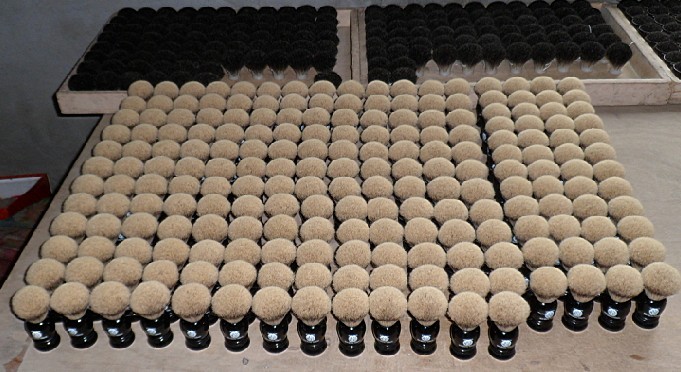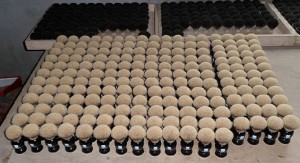Badgers are wild animals. They are extremely vicious as well. They have not been domesticated, nor have any serious attempts been made. Badgers are a vermin and a pest in China. They are protected in the UK and many parts of Europe.
Nearly all badger hair is sourced from trappers in China. The prevailing method of hunting is to gas the badger sett. The entire animal is used. The pelts are sold to fur traders and the meat is sold for food in poor areas. Both the Eurasian Badger (Meles Meles)* and the Hog (Manchurian) Badger (Arctonyx Collaris) are harvested. The top three grades of badger hair are harvested from the Eurasian Badger. Two-band Finest and black badger hair come from the Hog Badger.
A pictorial on available badger brush hair grades.
The pelts are then graded by the distributor and sold to knot manufacturers. Side note: These manufacturers either sell only knots or make whole brushes (either outsourcing the handle or also making them in-house like Edwin Jagger). The knot maker then removes the hair from the pelt and sorts the hair into the different grades of hair they sell.
Once the hair has been sorted by grade, the maker gathers the right amount of hair (by weight) and combs the hairs to remove any stray hairs and align the hairs properly. The hairs are then placed into a mold which gives the bulb the distinctive shape. The bottoms of the hairs are then tapped until all the tips are at the top. The knot is then bound with thread and the bottoms of the hairs cut off according to the desired loft. Finally, the plug is glued to the bottom to keep the knot in shape and the thread removed. Pictures of the process can be found here.
At this point, you may still be wondering where each grade of badger hair comes from. Silvertip is harvested from the white areas around the neck of the Eurasian Badger. A lower quality (slightly greyer) hair often called best or super is harvested from the lighter bands down the sides of the animal. Grey badger hair comes from the center of the back. Two-band finest badger hair is from the light areas of the Hog Badger. Black Badger hair comes from the large black areas of the Hog Badger. The lowest grade of badger hair consists of the castoffs.
China has regulated badger seasons and protected reserves where hunters may not harvest badgers. However, in the north, the Meles badger is considered a pest and more or less runs rampant. Also, in the rura areas, the government influence does not extend to all areas of life and so poaching may be common.
Badgers change their hair during the seasons. They grow a thick winter coat and shedding it come spring time. The Hog Badger lives in the tropical south and so may not shed its hair like its northern brethren. Since the point of trapping badgers is to harvest the hair for money, it is unlikely that the eurasian badger is trapped at all during the summer or early fall months.
Picture of Eurasian Badger Pelt.
Information courtesy of Wet Shaving Products – Makers of Fine Brushes for the Discerning Gentleman.
*There is a debate as to whether the Meles species consists of three distinct sub species. M. meles, M. Leucurs, & M. anakuma. China & some scholars believe they are all Meles meles. Some people disagree. The meles family has a large range that extends from Europe to Asia.


